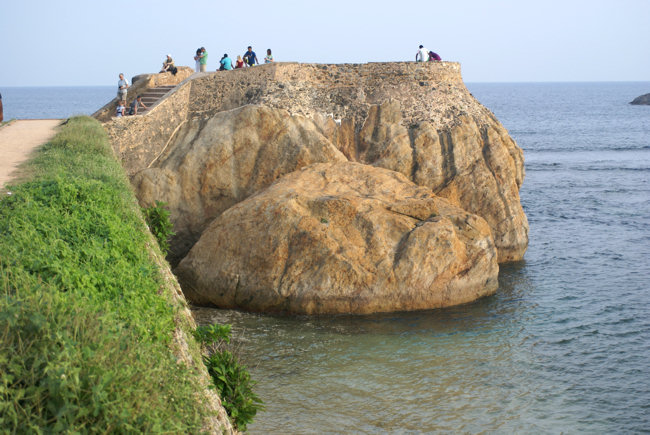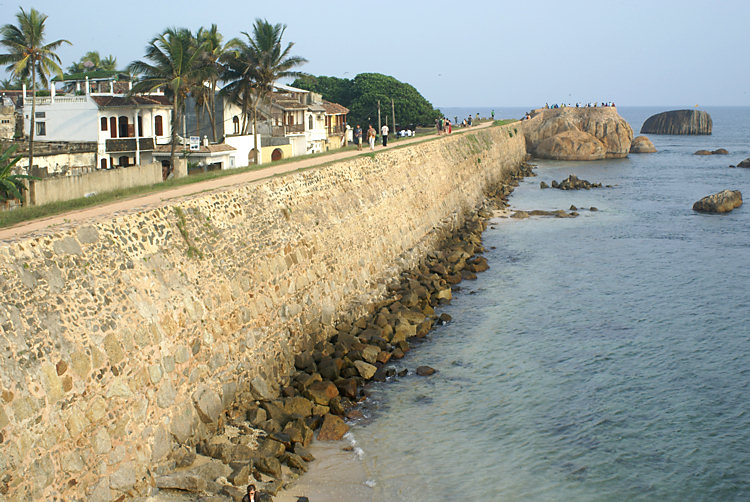Galle Flag Rock Bastion
Flag Rock Bastion on the Galle Fort costal defences. The builders of the city wall of the ancient port of Galle in southern Sri Lanka, used a naturally occurring large rock outcrop on which to build a defensive wall called flag rock.

Galle Flag Rock Bastion in Sri Lanka
It is the most southerly bastion on the sea wall. Looking west you get great views of the Galle Lighthouse, on top of the Utrecht Bastion, and Gun powder Museum opposite the ornate white painted Fort Meeran Jumma Masjid mosque.
If you look towards the east along the rampart you will see the Triton Bastion in front of the Neptune and Clippenburg Bastion. There is no charge to wall around the port walls. These Bastions and ramparts were started by the Dutch in 1663 and then reinforced by the British when they captured Galle Fort on 23rd February 1796.
There are some dangerous rocks near Flag Rock Bastion. Some are visible above the water surface but many are not. They are extremely hazardous to shipping. During good visibility flags were used to signal warnings to passing ships. This is how it got its name. In poor visibility muskets were fired from the nearby Pigeon island. This all became redundant when the light house was built.

Galle Flag Rock Bastion at the end of the rampart fort wall in Sri Lanka. You can also see pigeon island.
You will encounter a lot of courting couples walking the walls trying to find some space away from the crowded family homes. School children use the walls as a playground and jump off the ramparts into the see. Sometimes they try to get tourists to sponsor their jump. Avoid the snake charmers. Do not fund their cruel activity. If you take a photograph you will be pursued for money, sometimes by a snake charmer carrying a venomous snake in his out stretched hands.
What is a Bastion
They are gun platforms with minimal protection for the gunners. The Galle Fort guns used on dry land were normally larger than those on the enemy's ships. They had a longer range and could keep firing at those ship, hopefully destroying them, before the Galle gun emplacements were within range of the onboard guns. The land based cannons could also fire heated shot. If a man of war was hit by one of these red hot cannon balls there was a danger that the wooden timbers of the ship would burst into flame. For obvious reason using red hot shot on a wooden ship was not a good idea.
Rampart Street
Running parallel with the sea wall of Galle is Rampart Street. Here you will find little bed and breakfast accommodation offering sea and sun set views. There are a number of gift shops as well cafes. This is where you want to be in the late evening as it turns to dusk. Go and find a table with a good view in the upstairs dinning floor of one of the restaurants. Have something to eat and a drink whilst enjoying the sunset. If you leave it too late all the tables will be taken.
Between the Neptune and Flag Rock Bastion you will find the interesting Pedlar street that runs east west across the old town. It is great for a stroll. It has some charming small restaurants, shops and hotels. The Galle Fort walls helped protect the old city from the 2004 Tsunami. As Colombo grew and took more international trade so the importance of Galle fell. This is a good thing for the tourist as rather than being redeveloped the old houses were left for us to enjoy. More money has recently been invested in restoring Galle to its former colonial glory.
Travel books

